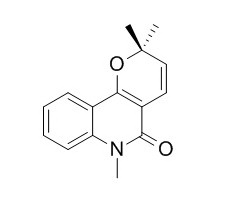N-Methylflindersine
N-Methylflindersine shows strong toxicity towards brine shrimp larvae, with an LD(50) value of 1.39 microg/ml. It also exhibits potent inhibition against N -formylmethionylleucylphenylalanine-induced superoxide production with IC(50) values less than 12 microM.
Inquire / Order:
manager@chemfaces.com
Technical Inquiries:
service@chemfaces.com
Tel:
+86-27-84237783
Fax:
+86-27-84254680
Address:
1 Building, No. 83, CheCheng Rd., Wuhan Economic and Technological Development Zone, Wuhan, Hubei 430056, PRC
Providing storage is as stated on the product vial and the vial is kept tightly sealed, the product can be stored for up to
24 months(2-8C).
Wherever possible, you should prepare and use solutions on the same day. However, if you need to make up stock solutions in advance, we recommend that you store the solution as aliquots in tightly sealed vials at -20C. Generally, these will be useable for up to two weeks. Before use, and prior to opening the vial we recommend that you allow your product to equilibrate to room temperature for at least 1 hour.
Need more advice on solubility, usage and handling? Please email to: service@chemfaces.com
The packaging of the product may have turned upside down during transportation, resulting in the natural compounds adhering to the neck or cap of the vial. take the vial out of its packaging and gently shake to let the compounds fall to the bottom of the vial. for liquid products, centrifuge at 200-500 RPM to gather the liquid at the bottom of the vial. try to avoid loss or contamination during handling.
Life (Basel).2021, 11(7):616.
Microchemical Journal2018, 137:168-173
Korean Journal of Pharmacognosy2014, 113-120
Nutrients.2017, 10(1)
Regul Toxicol Pharmacol.2023, 142:105433.
Phytomedicine.2018, 38:12-23
Geroscience.2024, 01207-y.
Evid Based Complement Alternat Med.2020, 2020:9416962.
Molecules.2023, 28(19):6767.
Molecules.2019, 24(16):E2985
Related and Featured Products
Chem Pharm Bull (Tokyo). 2009 Jun;57(6):600-2.
Alkaloids from the stem bark of Micromelum falcatum.[Pubmed:
19483341]
METHODS AND RESULTS:
Two new quinoldione alkaloids, methyl 2-(3-hydroxy-1-methyl-2,4-dioxo-1,2,3,4-tetrahydroquinolin-3-yl)acetate (1) and 3-hydroxy-1-methyl-3-(2-oxopropyl)quinoline-2,4(1H,3H)-dione (2), and two quinolinone alkaloids previously synthesized but first isolated as natural products, N-Methylflindersine (3) and 4-hydroxy-3-methoxy-1-methyl-2(1H)-quinolinone (4), were isolated from the stem bark of Micromelum falcatum, together with the known N-methylswietenidine-B (5). Their structures were established mainly on the basis of 1D- and 2D-NMR techniques.
CONCLUSIONS:
All compounds were evaluated for toxicity towards brine shrimp larvae, and 3 showed strong toxicity with an LD(50) value of 1.39 microg/ml.
J Nat Prod. 2007 Sep;70(9):1444-8.
New phenylpropenoids, bis(1-phenylethyl)phenols, bisquinolinone alkaloid, and anti-inflammatory constituents from Zanthoxylum integrifoliolum.[Pubmed:
17822293 ]
METHODS AND RESULTS:
Five new compounds, including two new phenylpropenoids, (R,E)-1-[4-(3-hydroxyprop-1-enyl)phenoxy]-3-methylbutane-2,3-diol (1) and 4-hydroxy-3-(3-methyl-2-butenyl)cinnamyl alcohol (2), two new bis(1-phenylethyl)phenols, 2,6-bis(1-phenylethyl)phenol (3) and 2,4-bis(1-phenylethyl)phenol (4), and a new bisquinolinone alkaloid, 18-demethylparaensidimerin C (5), together with 17 known compounds have been isolated from the stem wood of Zanthoxylum integrifoliolum. The structures of these new compounds were determined through spectral analyses including extensive 2D nuclear magnetic resonance data.
CONCLUSIONS:
Among the isolates, N-Methylflindersine (7), (-)-simulanol (10), and evofolin-C (16) exhibited potent inhibition against N-formylmethionylleucylphenylalanine-induced superoxide production with IC(50) values less than 12 microM.
Molecules. 2014 Sep 16;19(9):14637-48.
A novel 3,9-(1,2,3-trioxocine)-type steroid of Rauia nodosa (Rutaceae).[Pubmed:
25230120]
METHODS AND RESULTS:
A new natural product, a 3,9-(1,2,3-trioxocine)-type steroid, named rauianodoxy (6), was isolated from Rauia nodosa, together with five steroids: sistostenone (1), stigmastenone (2), sitosterol (3), stigmasterol (4) and ergosterol peroxide (5), one coumarin, O-geranylosthenol (7), and three alkaloids, N-Methylflindersine (8), zantobungeanine (9) and veprissine (10). Compounds 5-8 were isolated for the first time in the genus Rauia. These compounds were characterized on the basis of their spectral data, mainly one and two-dimensional NMR, and mass spectra, also involving comparison with the literature data.
CONCLUSIONS:
Theoretical studies at the DFT level reveal structural parameters for the 1,2,3-trioxole bridge compatible with known structures containing a similar group.



